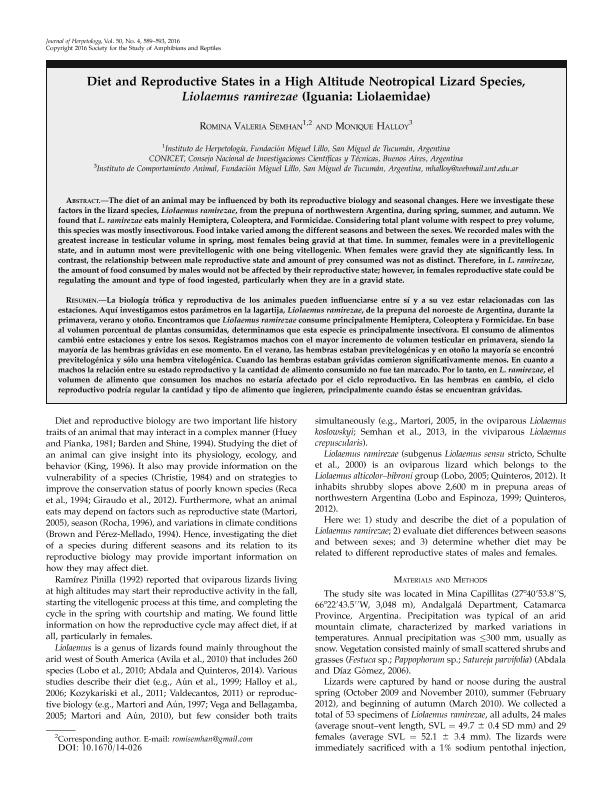Artículo
La biología trófica y reproductiva de los animales pueden influenciarse entre sí y a su vez estar relacionadas con las estaciones. Aquí investigamos estos parámetros en la lagartija, Liolaemus ramirezae, de la prepuna del noroeste de Argentina, durante la primavera, verano y otoño. Encontramos que Liolaemus ramirezae consume principalmente Hemiptera, Coleoptera y Formicidae. En base al volumen porcentual de plantas consumidas, determinamos que esta especie es principalmente insectívora. El consumo de alimentos cambió entre estaciones y entre los sexos. Registramos machos con el mayor incremento de volumen testicular en primavera, siendo la mayoría de las hembras grávidas en ese momento. En el verano, las hembras estaban previtelogénicas y en otoño la mayoría se encontró previtelogénica y sólo una hembra vitelogénica. Cuando las hembras estaban grávidas comieron significativamente menos. En cuanto a machos la relación entre su estado reproductivo y la cantidad de alimento consumido no fue tan marcado. Por lo tanto, en L. ramirezae, el volumen de alimento que consumen los machos no estaría afectado por el ciclo reproductivo. En las hembras en cambio, el ciclo reproductivo podría regular la cantidad y tipo de alimento que ingieren, principalmente cuando éstas se encuentran grávidas. The diet of an animal may be influenced by both its reproductive biology and seasonal changes. Here we investigate these factors in the lizard species, Liolaemus ramirezae, from the prepuna of northwestern Argentina, during spring, summer, and autumn. We found that L. ramirezae eats mainly Hemiptera, Coleoptera, and Formicidae. Considering total plant volume with respect to prey volume, this species was mostly insectivorous. Food intake varied among the different seasons and between the sexes. We recorded males with the greatest increase in testicular volume in spring, most females being gravid at that time. In summer, females were in a previtellogenic state, and in autumn most were previtellogenic with one being vitellogenic. When females were gravid they ate significantly less. In contrast, the relationship between male reproductive state and amount of prey consumed was not as distinct. Therefore, in L. ramirezae, the amount of food consumed by males would not be affected by their reproductive state; however, in females reproductive state could be regulating the amount and type of food ingested, particularly when they are in a gravid state.
Diet and Reproductive States in a High Altitude Neotropical Lizard Species, Liolaemus ramirezae (Iguania: Liolaemidae)
Fecha de publicación:
12/2016
Editorial:
Society for the Study of Amphibians and Reptiles
Revista:
Journal of Herpetology
ISSN:
0022-1511
Idioma:
Inglés
Tipo de recurso:
Artículo publicado
Clasificación temática:
Resumen
Palabras clave:
Food Intake
,
Liolaeminae
,
Reproduction
,
Seasons
Archivos asociados
Licencia
Identificadores
Colecciones
Articulos(UEL)
Articulos de UNIDAD EJECUTORA LILLO
Articulos de UNIDAD EJECUTORA LILLO
Citación
Semhan, Romina Valeria; Halloy, Monique; Diet and Reproductive States in a High Altitude Neotropical Lizard Species, Liolaemus ramirezae (Iguania: Liolaemidae); Society for the Study of Amphibians and Reptiles; Journal of Herpetology; 50; 4; 12-2016; 589-593
Compartir
Altmétricas




